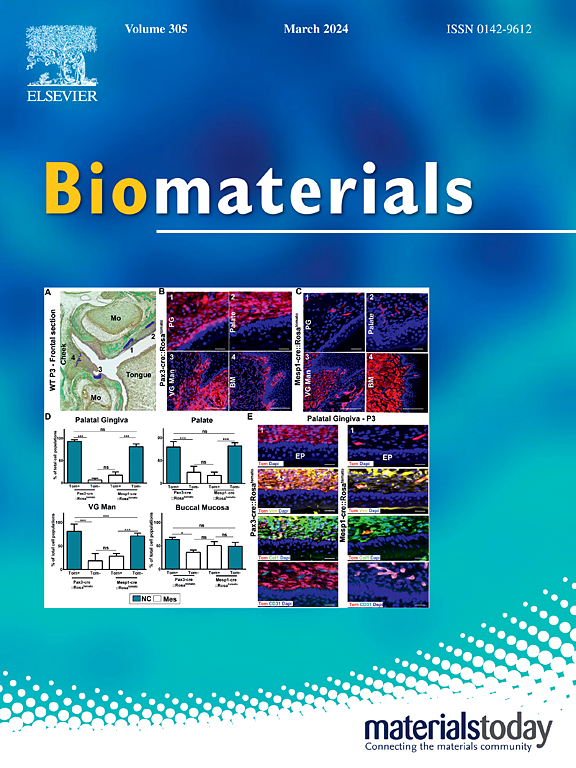A heterojunction-engineering nanodrug with tumor microenvironment responsiveness for tumor-specific cuproptosis and chemotherapy amplified sono-immunotherapy
IF 12.8
1区 医学
Q1 ENGINEERING, BIOMEDICAL
引用次数: 0
Abstract
Cuproptosis has recently identified as a unique copper-dependent cell death mechanism that may provide new opportunities for improving the therapeutic effect of tumor therapy through triggering efficient adaptive immune responses. However, the poor delivery efficiency and non-tumor-specific release of Cu ions would restrict the potential clinical applications of cuproptosis inducers. Herein, we report for the first time the development of hollow Cu2-xSe nanocubes as the tumor microenvironment (TME)-responsive drug delivery systems and cuproptosis inducers for tumor-specific chemotherapy and cuproptosis. The presence of Cu vacancy endows Cu2-xSe with excellent sonodynamic and chemodynamic activity. The hollow Cu2-xSe nanocubes with TME-responsive degradation behaviors are further utilized to load graphene quantum dot (GQD) nanodrugs to form GQD/Cu2-xSe heterojunctions for achieving tumor-specific chemotherapy. The heterojunction-fabrication GQD/Cu2-xSe exhibits amplified ROS generation capabilities and improved TME regulation ability owing to the optimized electron-hole separation kinetics. More importantly, the significant increase in ROS levels and efficient cuproptosis could reverse the immunosuppressive TME and induce immunogenic cell death that stimulates strong systemic immune responses to eliminate tumors. Collectively, this work presents an innovative strategy for the utilization of TME-responsive cuproptosis inducers for tumor-specific chemotherapy and cuproptosis augmented sono-immunotherapy.
一种具有肿瘤微环境反应性的异结工程纳米药物,用于肿瘤特异性铜增生和化疗放大超声免疫治疗
铜增生最近被确定为一种独特的铜依赖细胞死亡机制,可能为通过触发有效的适应性免疫反应来提高肿瘤治疗效果提供新的机会。然而,铜离子的递送效率较差和非肿瘤特异性释放限制了铜增生诱导剂的潜在临床应用。在此,我们首次报道了空心Cu2-xSe纳米立方体作为肿瘤微环境(TME)反应性药物递送系统和cuprotosis诱导剂的发展,用于肿瘤特异性化疗和cuprotosis。Cu空位的存在使Cu2-xSe具有优异的声动力学和化学动力学活性。进一步利用具有tme响应降解行为的空心Cu2-xSe纳米立方体负载石墨烯量子点(GQD)纳米药物,形成GQD/Cu2-xSe异质结,实现肿瘤特异性化疗。由于优化了电子-空穴分离动力学,异质结制备的GQD/Cu2-xSe具有增强的ROS生成能力和提高的TME调节能力。更重要的是,ROS水平的显著增加和有效的铜增生可以逆转免疫抑制性TME,诱导免疫原性细胞死亡,从而刺激强烈的全身免疫反应来消除肿瘤。总的来说,这项工作提出了一种创新的策略,利用tme反应性铜增生诱导剂进行肿瘤特异性化疗和铜增生增强超声免疫治疗。
本文章由计算机程序翻译,如有差异,请以英文原文为准。
求助全文
约1分钟内获得全文
求助全文
来源期刊

Biomaterials
工程技术-材料科学:生物材料
CiteScore
26.00
自引率
2.90%
发文量
565
审稿时长
46 days
期刊介绍:
Biomaterials is an international journal covering the science and clinical application of biomaterials. A biomaterial is now defined as a substance that has been engineered to take a form which, alone or as part of a complex system, is used to direct, by control of interactions with components of living systems, the course of any therapeutic or diagnostic procedure. It is the aim of the journal to provide a peer-reviewed forum for the publication of original papers and authoritative review and opinion papers dealing with the most important issues facing the use of biomaterials in clinical practice. The scope of the journal covers the wide range of physical, biological and chemical sciences that underpin the design of biomaterials and the clinical disciplines in which they are used. These sciences include polymer synthesis and characterization, drug and gene vector design, the biology of the host response, immunology and toxicology and self assembly at the nanoscale. Clinical applications include the therapies of medical technology and regenerative medicine in all clinical disciplines, and diagnostic systems that reply on innovative contrast and sensing agents. The journal is relevant to areas such as cancer diagnosis and therapy, implantable devices, drug delivery systems, gene vectors, bionanotechnology and tissue engineering.
 求助内容:
求助内容: 应助结果提醒方式:
应助结果提醒方式:


